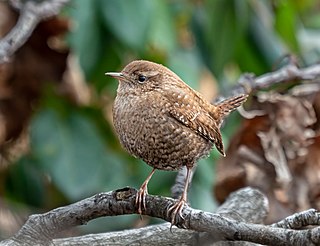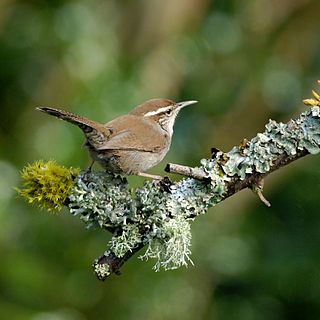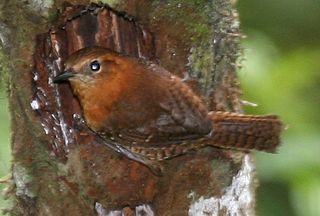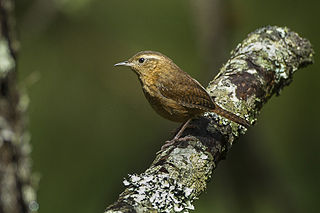
Wrens are a family of brown passerine birds in the predominantly New World family Troglodytidae. The family includes 88 species divided into 19 genera. Only the Eurasian wren occurs in the Old World, where, in Anglophone regions, it is commonly known simply as the "wren", as it is the originator of the name. The name wren has been applied to other, unrelated birds, particularly the New Zealand wrens (Acanthisittidae) and the Australian wrens (Maluridae).

The winter wren is a very small North American bird and a member of the mainly New World wren family Troglodytidae. The species contained the congeneric Pacific wren of western North America and Eurasian wren (Troglodytes troglodytes) of Eurasia until they were split in 2010.

The northern house wren is a very small passerine in the wren family Troglodytidae. It found in southern Canada, the USA and Mexico. It occurs in most suburban areas in its range. It formerly included many subspecies resident in South America and in the Caribbean that are now considered as separate species. The name troglodytes means "hole dweller", and is a reference to the bird's tendency to disappear into crevices when hunting insects or to seek shelter.

The Bewick's wren is a wren native to North America. It is the only species placed in the genus Thryomanes. At about 14 cm (5.5 in) long, it is grey-brown above, white below, with a long white eyebrow. While similar in appearance to the Carolina wren, it has a long tail that is tipped in white. The song is loud and melodious, much like the song of other wrens. It lives in thickets, brush piles and hedgerows, open woodlands and scrubby areas, often near streams. It eats insects and spiders, which it gleans from vegetation or finds on the ground.

Troglodytes is a genus of small passerine birds in the wren family. These wrens are around 11–13 centimetres (4.3–5.1 in) long. They are brownish above and somewhat paler below, with strong legs. Their short rounded wings and frequently cocked tail have a dark barred pattern. The flight is direct and buzzing.

The ochraceous wren is a small songbird of the wren family. It is a resident breeding species in Costa Rica, Panama, and Colombia.
The Daito wren is a controversial subspecies of the Eurasian wren. It is known only by the type specimen, a male collected in 1938 on Minami Daitō-jima, the main island of the Daito Archipelago east of Okinawa. Yamashina described the bird as a new subspecies after comparing it with 114 specimens from surrounding areas and under the impression that the Eurasian wren is a fairly sedentary bird, not liable to be drifted astray over long distances. Its scientific name honors Yamashina's specimen collector, Hyojiri Orii.

Cobb's wren is a fairly small (12-13.5 cm) wren which is endemic to the Falkland Islands. It was formerly classified as a subspecies of the northern house wren but is now commonly considered to be a separate species due to differences in plumage, voice, ecology and morphology.

The Santa Marta wren is a species of bird in the family Troglodytidae. It is endemic to Colombia.

The rufous-browed wren is a species of bird in the family Troglodytidae. It is found in Central America from Mexico south into Nicaragua.

The mountain wren is a species of bird in the family Troglodytidae. It is found in the Andes of northwestern Argentina, Bolivia, Colombia, Ecuador, Peru, and western Venezuela.

The Clarión wren is a species of bird in the family Troglodytidae. It is endemic to Clarión Island off Pacific Mexico.

The brown-throated wren is a mostly Mexican bird in the wren family, often considered a subspecies of the house wren.

The St Kilda wren is a small passerine bird in the wren family. It is a distinctive subspecies of the Eurasian wren endemic to the islands of the isolated St Kilda archipelago, in the Atlantic Ocean 64 kilometres (40 mi) west of the Outer Hebrides, Scotland.
The Fair Isle wren is a small passerine bird in the wren family. It is a subspecies of the Eurasian wren endemic to Fair Isle, Shetland, Scotland, an island about halfway between mainland Shetland and Orkney. It was first described by the British ornithologist Kenneth Williamson in 1951.
The Shetland wren is a small passerine bird in the wren family. It is a subspecies of the Eurasian wren endemic to the Shetland archipelago of Scotland, with the exception of Fair Isle which has its own endemic subspecies, the Fair Isle wren. The Shetland wren is distinguished by its darker and more rufous-brown colouring from the mainland form, with a heavily barred underside, the barring extending from belly to breast. The bill is stouter and longer and it has stronger legs.

The Eurasian wren or northern wren is a very small insectivorous bird, and the only member of the wren family Troglodytidae found in Eurasia and Africa (Maghreb). In Anglophone Europe, it is commonly known simply as the wren. It has a very short tail which is often held erect, a short neck and a relatively long thin bill. It is russet brown above, paler buff-brown below and has a cream buff supercilium. The sexes are alike.

The Pacific wren is a very small North American bird and a member of the mainly New World wren family Troglodytidae. It was once lumped with Troglodytes hiemalis of eastern North America and Troglodytes troglodytes of Eurasia as the winter wren.
The Cozumel wren is a very small passerine bird in the wren family Troglodytidae that is endemic to the small island of Cozumel off the eastern coast of Mexico. The name troglodytes means "hole dweller", and is a reference to the bird's tendency to disappear into crevices when hunting insects or to seek shelter. It was formerly considered to be conspecific with the northern house wren.
The Kalinago wren is a very small passerine bird in the wren family Troglodytidae that is found on the Caribbean island of Dominica. It was formerly also found on the islands of Martinique and Guadeloupe. The name troglodytes means "hole dweller", and is a reference to the bird's tendency to disappear into crevices when hunting insects or to seek shelter. It was formerly considered to be conspecific with the house wren, now renamed the northern house wren.














